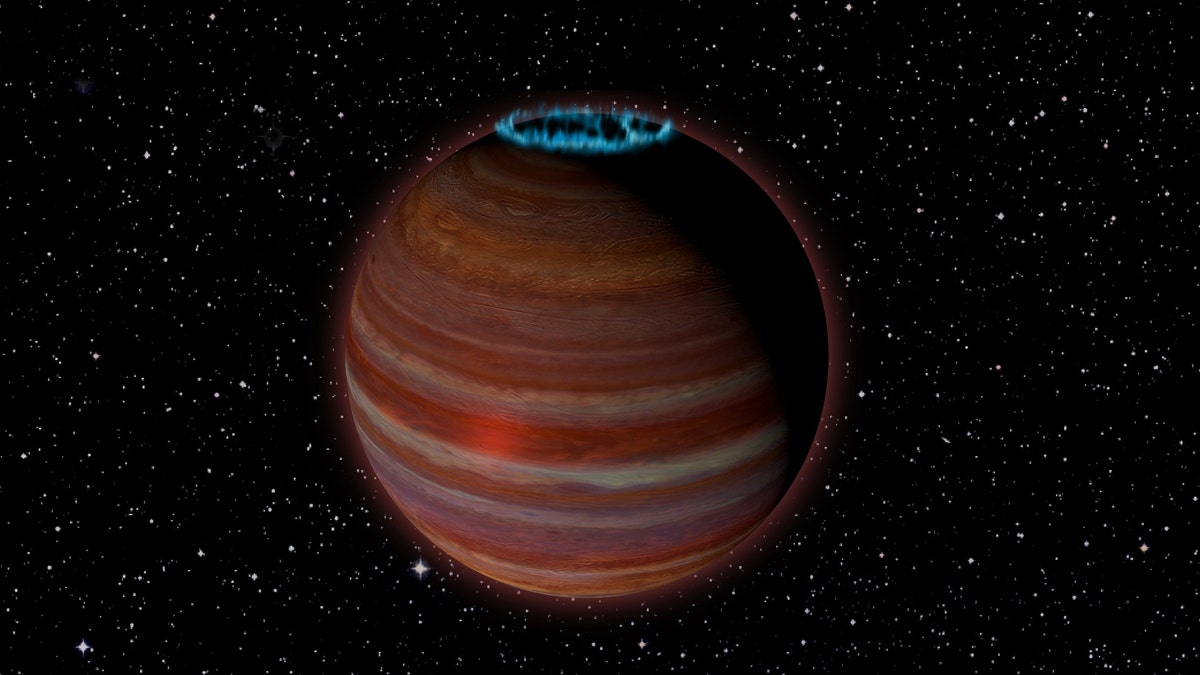
Artist's conception of SIMP J01365663+0933473, an object with 12.7 times the mass of Jupiter, but a magnetic field 200 times more powerful than Jupiter's. This object is 20 light-years from Earth. Credit: Caltech/Chuck Carter; NRAO/AUI/NSF
A massive glowing "rogue" planetary-mass object has been discovered, surprising scientists with not only its size, but also the fact it's not orbiting a star.
The object, named SIMP J01365663+0933473, has a magnetic field more than 200 times stronger than Jupiter’s and is nearly 13 times the size of the gas giant. At its size, it's right between the size of a planet and a failed star, so scientists will need to study it further to determine exactly what it is.
“This object is right at the boundary between a planet and a brown dwarf, or ‘failed star,’ and is giving us some surprises that can potentially help us understand magnetic processes on both stars and planets,” said Caltech graduate student Melodie Kao, who led the study, in a statement.
MYSTERIOUS 'SUPER EARTH' PLANET 'MOST LIKELY' CANDIDATE TO HOST LIFE - BUT THERE'S A HUGE PROBLEM
The study's findings have been published in the Astrophysical Journal.
Kao and her team are surprised that the object isn't orbiting a star, a typical behavior of planets.
“Detecting SIMP J01365663+0933473 with the VLA through its auroral radio emission also means that we may have a new way of detecting exoplanets, including the elusive rogue ones not orbiting a parent star,” Caltech's Gregg Hallinan added in the statement.
Originally discovered in 2016, it was only recently that it was identified as a planetary-mass object, having originally been classified as a brown dwarf. Once more data was obtained, the idea that SIMP J01365663+0933473 was a brown dwarf was scrapped.
It's thought that SIMP J01365663+0933473 is only 200 million years-old and is just 20 light-years away from Earth. It also has a surface temperature of 1,500 degrees Fahrenheit, compared to minus 234 degrees Fahrenheit for Jupiter and 10,000 degrees Fahrenheit for the Sun.
It was first detected using a radio telescope, the National Science Foundation's Karl G. Jansky Very Large Array.
NEARBY ALIEN PLANET MA BE CAPABLE OF SUPPORTING LIFE
Aside from its glow, seen in the picture, and its other uncharacteristic traits, SIMP J01365663+0933473 may help scientists discover other worlds, known as exoplanets, as well as understand these far-away celestial bodies.
“This particular object is exciting because studying its magnetic dynamo mechanisms can give us new insights on how the same type of mechanisms can operate in extrasolar planets — planets beyond our Solar System," Kao said.
She continued: "We think these mechanisms can work not only in brown dwarfs, but also in both gas giant and terrestrial planets.”
Follow Chris Ciaccia on Twitter @Chris_Ciaccia